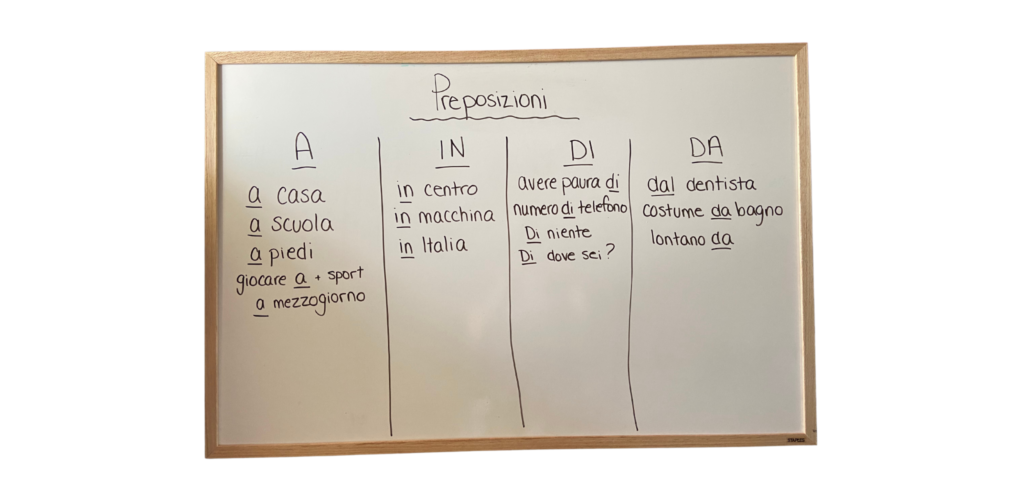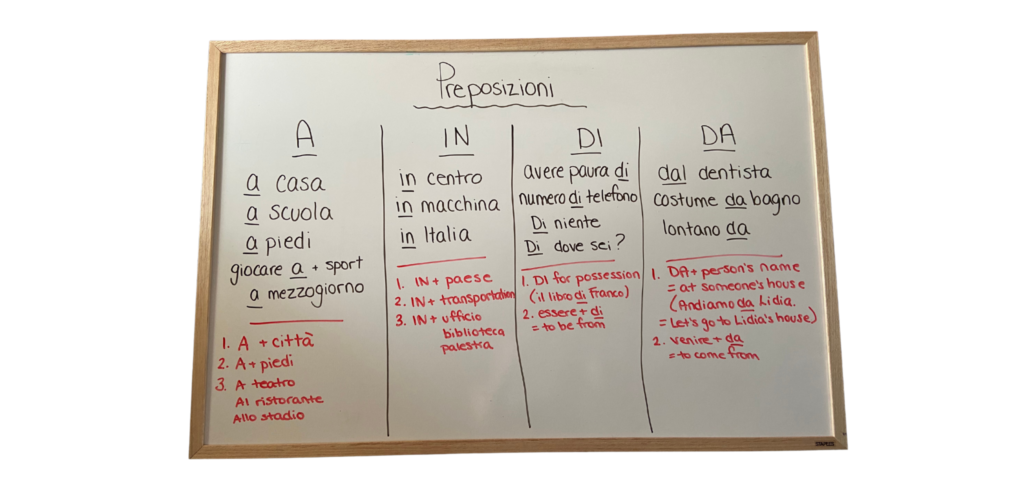How to Teach Italian Prepositions for Beginners
Teaching Italian prepositions is one of those topics that is no Italian teacher’s favourite… right??
Let’s be honest, there are SO many rules, phrasal verbs, expressions, exceptions and just a lot of information that can’t all be given at one time to a student who is just starting out. It would be super overwhelming, confusing, and just downright disheartening!
So how do we decide where to start? And, how do we organize a prepositions lesson in a way that helps students feel less overwhelmed by the topic?
I wanted to share how I set up my FIRST Italian prepositions grammar lesson of the year. I have found this to be really effective and helpful for my students, so maybe it will help you with ideas for your lessons too!
STEP 1: The Board Set up
At the very beginning of the grammar lesson (we always do a fun warm-up before this part!), I organize the board into columns and write the most common Italian prepositions at the top. I like to start with a / in / di / da. Make sure to leave lots of space so that you can add the others and/or give lots of examples!
The board set up is key to the whole lesson because it gives students an easy reference sheet and shows them how they can organize their notes as they learn more ways that the prepositions are used. Students love charts and formulas!
This is how I set up my board:
(This is my whiteboard at home that I’m using as an example. In real life you can add more prepositions if you want and have more space!)

STEP 2: Class Examples
For the next part of the lesson, I try to focus on showing students the Italian prepositions that they are already using!
Often students don’t realize that so many of the phrases they have been reading and writing already contain prepositions. I mean, some students (and adults!) don’t know what prepositions are even in English without it being explained.
I ask students to think of ways that they have seen the prepositions used before throughout their Italian learning and I write the examples into the proper columns.
As students give you examples, try to write them out in categories so that later when you ask for patterns, students are able to identify them more easily!
I also prepare a summary for myself of common ways students have already seen prepositions in our lessons. This way I can help remind them if they get stuck!
**This is a FREE DOWNLOAD of prepositions that my students have usually been exposed to before the start of the lesson. Feel free to use it as a guide and add your own based on what your students have learned!
At this point, my board looks something like this: (again, I just put limited examples on the board because I am using my home whiteboard. You have tons more + different examples in the classroom!)

STEP 3: In With the New
After we have come up with a big list of examples together, I draw a line across the columns to show that we are now starting to add the new material to our lists!
For this part, I begin by asking students if they notice and trends within the columns (in + country, a + city, in + month, in + vehicles, etc).
Under the line, I start adding + explaining the new prepositional rules / ways that prepositions are used that we are going to focus on in the lesson.
Here is an example of how that looks on the board:

Here is a FREE DOWNLOAD of a list that I like to use of common beginner rules for Italian prepositions that you can use as an example if you are looking for ideas!
STEP 4: Practice
After the whole list has been completed and I have introduced the new prepositional phrases / rules, we practice together as a class!
I try to make this part fun and get students working together in pairs or small groups so that they aren’t just sitting and looking at grammar for too long.
** I also have a free Kahoot! that you can use for this under the username: djohns8, Kahoot name: Preposizioni – Lezione 1 **

And there you have it!
This is how I introduce Italian prepositions and set my students up for effective note taking as we continue through our lessons.
I hope this was useful for you and that it makes teaching Italian prepositions just a little bit more enjoyable!
Looking for more fun things to do with your Italian class? Check out this post with 10 Fun Warm-Ups for your Italian Classroom!





